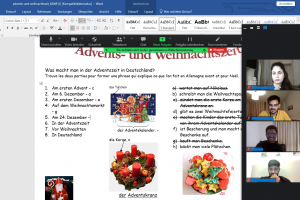
Unveiling the debate: Can AI replace human language educators?
In today’s rapidly evolving digital landscape, the question of whether artificial intelligence (AI) will replace real language teachers in adult education is a topic of considerable debate. Therefore, there are numerous studies and research articles exploring the role of AI in language education and its comparison to human language teachers. While these studies provide valuable insights, it’s essential to note that the field of AI in education is continually evolving, and opinions on the matter may vary.
But first… what is AI in terms of language learning?
AI in language learning for adults refers to the integration of advanced technologies, such as machine learning algorithms, natural language processing (NLP), and artificial neural networks, to enhance and optimize the language learning experience for adult learners. AI in language learning encompasses a wide range of applications and tools designed to assist learners in acquiring, practicing, and mastering a foreign language.
At its core, AI in language learning aims to provide personalized and adaptive instruction tailored to the individual needs, preferences, and proficiency levels of adult learners. By analyzing learner data, AI-driven platforms can identify areas for improvement, track progress, and deliver targeted feedback to optimize learning outcomes.
Key features of AI in language learning for adults may include:
- Adaptive Learning Platforms: AI-driven adaptive learning platforms analyze learner data, such as performance on exercises and quizzes, to dynamically adjust the difficulty and content of lessons. For example, if a learner struggles with a particular grammar concept, the platform may provide additional practice exercises or offer targeted explanations until mastery is achieved. The most common examles of adaptive learning platforms are Duolingo, Rosetta Stone, Babbel, Memrise and Busuu.
- Language Assessment and Placement Tests: AI-powered language assessment tools evaluate learners’ language skills through various tasks, such as listening comprehension, reading comprehension, and writing proficiency. Based on the results, learners are placed into appropriate proficiency levels or recommended personalized learning paths. Two famous examples are the TOEFL iBT (Test of English as a Foreign Language, Internet-Based Test) and the IELTS (International English Language Testing System).
- Speech Recognition and Pronunciation Feedback: AI technology enables speech recognition capabilities that accurately transcribe and assess learners’ spoken language. Learners can practice pronunciation through interactive exercises, and AI provides instant feedback on accuracy, intonation, and fluency, helping learners improve their spoken proficiency. A few examples are the language learning platforms Speechling, Pronunciator and FluentU, the learning tool SayIt AI and the language exchange app Tandem.
- Virtual Language Tutors and Chatbots: AI-driven virtual tutors and chatbots engage learners in simulated conversations, providing interactive language practice in real-time. Learners can practice speaking and listening skills, ask questions, and receive immediate feedback and guidance from the AI tutor or chatbot. Some examples of virtual language tutors and chatbots that utilize AI technology to assist language learners are the language exchange apps Tandem, Reverso Context and HelloTalk and the language learning platform Busuu and Lingvist.
- Language Translation and Immersion Tools: AI-powered language translation tools assist learners in understanding and translating text in real-time. These tools can be integrated into language courses to provide immersive experiences, allowing learners to explore authentic materials in the target language, such as articles, videos, and social media posts, with instant translation support. The most famous language translation and immersion tool that employs AI-driven neural machine translation (NMT) technology, ist Google Translate. The tool translates text, websites, documents, and even real-time conversations between languages, utilizing AI algorithms to improve translation accuracy and fluency. Some other examples are Microsoft Translator, DeepL, Babylon Translator and FluentU.
- Text Analysis and Writing Assistance: AI-driven text analysis tools analyze learners’ writing samples for grammar, vocabulary usage, and coherence. Learners receive feedback and suggestions for improving their writing skills, such as grammar corrections, vocabulary enrichment, and stylistic enhancements. Some examples are Grammarly, Hemingway Editor, ProWritingAid and Ginger.
- Cultural and Contextual Learning Modules: AI-powered modules provide insights into cultural nuances and contextual usage of language. Learners explore cultural topics, idiomatic expressions, and situational language use through interactive multimedia content, simulations, and virtual experiences, enhancing their cultural awareness and communication skills. The language platforms Cultural Detective, Rosetta Stone, Mango Languages, Transparent Language Online and FluentU offer cultural and contextual learning experiences for example through authentic videos and interactive exercises.
While AI technology has obviously made significant strides in recent years, particularly in areas such as language translation and speech recognition, it is essential to recognize the unique strengths and capabilities that human teachers bring to the table.
In summary, while there is research suggesting that AI can enhance language learning outcomes and provide valuable support to learners, there is no definitive evidence to suggest that AI can fully replace real human language teachers. The role of human instructors remains vital in providing personalized, engaging, and culturally responsive instruction that meets the diverse needs of language learners. Human instructors offer invaluable qualities such as empathy, cultural understanding, and the ability to tailor instruction to individual learning styles and preferences.
LexiΣ Academy firmly believes that human instructors will continue to play a vital role in guiding, motivating, and inspiring learners on their language learning journey. At LexiΣ Academy, we believe that AI and human instructors can complement each other, offering a holistic approach to language learning that maximizes effectiveness and efficiency. We embrace the integration of AI technology into our curriculum to augment the teaching expertise of our instructors and provide learners with a comprehensive and immersive learning experience. By harnessing the power of AI in conjunction with the expertise of our dedicated instructors, we strive to provide adult learners with the most effective, personalized, and enriching language learning experience possible.



